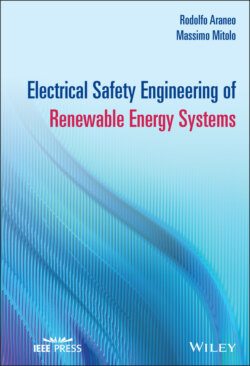Читать книгу Electrical Safety Engineering of Renewable Energy Systems - Rodolfo Araneo - Страница 19
1.5 Heated Surfaces of Electrical Equipment and Contact Burn Injuries
ОглавлениеBurns can also be triggered by unintentional contact with hot surfaces of electrical equipment, which may be readily accessible during normal operations (e.g., the surface of a PV module) [20, 21].
According to Stevens’ Law, the perception of temperature is also superlinear with the stimulus, as varies as the 1.6 power of the temperature (i.e., experimentally analyzed by using a heated metal on a person’s arm).
Most apparatus and appliances in industrial, commercial, and residential environments are thermally insulated unless the insulation would prevent their functions (e.g., the bottom surface of a flatiron). However, superficial temperatures of insulated equipment may still be high enough to cause burns from contact with readily accessible parts. The severity of such burns will depend on the thermal resistivity of the material of the touchable surface, and the pressure and duration of the contact.
An effective protection against burns can be established based on the acceptable contact period and on the level of acceptable injury.
According to the CENELEC Guide 295 for adults, a minimum contact period ranging between 0.5 s and 1 s should be used, based on the type of the equipment and where they are to be used (e.g., restrictive locations); however, extended reaction times may be considered based on the age of users that may possibly come into contact with the hot surface (Table 1.4).
Table 1.4 Standard contact durations
| Age Group | Exposure time (s) |
|---|---|
| Adults | 0.5–1 |
| age < 2 years | 15 |
| 2 years < age < 6 years | 4 |
| 6 years < age < 14 years | 2 |
| Elderly persons | 1–4 |
| Physical disabilities | According to nature of disability |
Once the maximum operating temperature of readily accessible surfaces is determined, by direct measurement or calculation, the potential injury level may be established through the graph of Figure 1.7, which shows the relationship between surface temperature and exposure time.
Figure 1.7 Temperature–Time Relationship for burns.
The bottom curve TB is the locus of the pairs temperature and exposure time representing the limit of the reversible epidermal injury; TB describes the acceptable injury level as a first degree burn, that is, a burn where the temperature and/or duration are not sufficient to cause necrosis of the epidermis but only reddening of the skin. TA is the locus representing the complete trans-epidermal necrosis.
The surface of photovoltaic arrays in full sun can exceed the ambient temperature by 30°C or more, which may easily produce temperature greater than 60˚C. It is therefore apparent that PV modules’ surface with temperatures exceeding 64˚C can only be contacted for 1 s before skin injury occurs.
IEC 60364-4-426 requires that accessible parts of electrical equipment within arm’s reach do not attain temperatures exceeding the limits given in Table 1.8, to prevent burns caused by contact with heated surfaces.
Table 1.8 Temperature limits in normal service for accessible parts of equipment
| Accessible parts | Material of accessible surfaces | Maximum temperatures (°C) |
|---|---|---|
| A hand-held part | Metallic | 55 |
| Non-metallic | 65 | |
| A part intended to be touched but not hand-held | Metallic | 70 |
| Non-metallic | 80 | |
| A part that does not need to be touched for normal operation | Metallic | 80 |
| Non-metallic | 90 |
The above temperature limits vary according to whether the part is intended to be hand-held or touched during normal use, and are based on the nature of the material of the accessible surface; they do not apply to equipment for which a maximum temperature is specified in the relevant product standard.
The temperature limits of Table 1.8 are rather large, and it would be prudent to be well below those values; if not possible, the equipment in question might be fitted with guards to prevent accidental contact.
